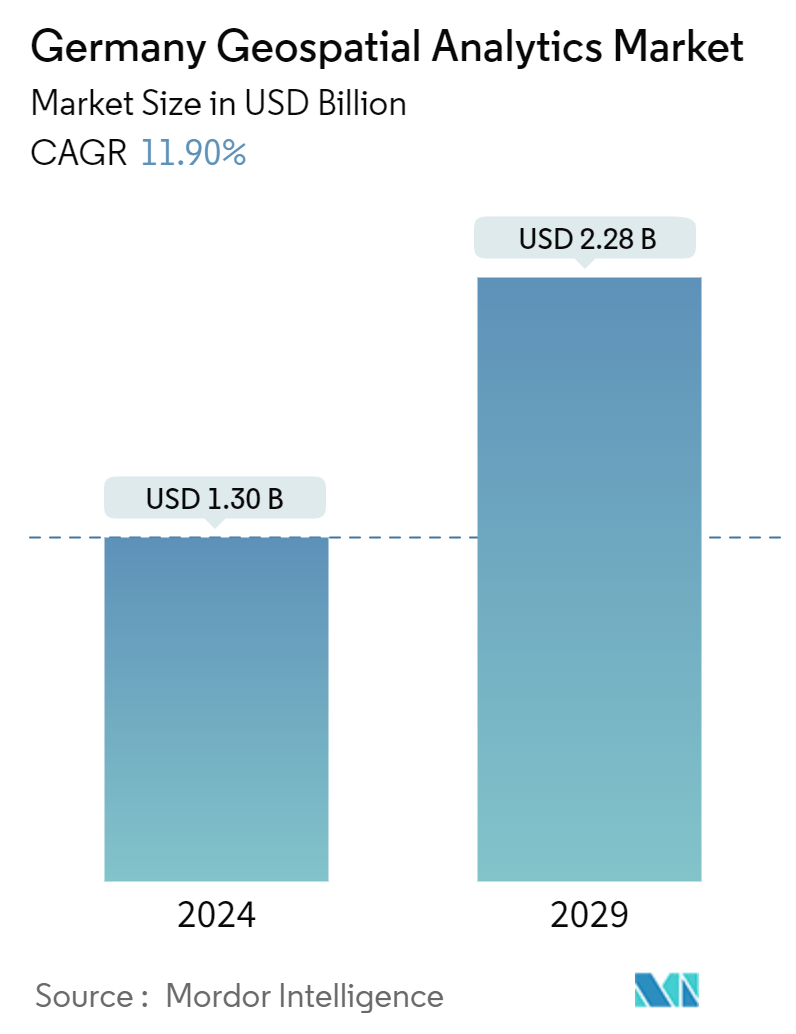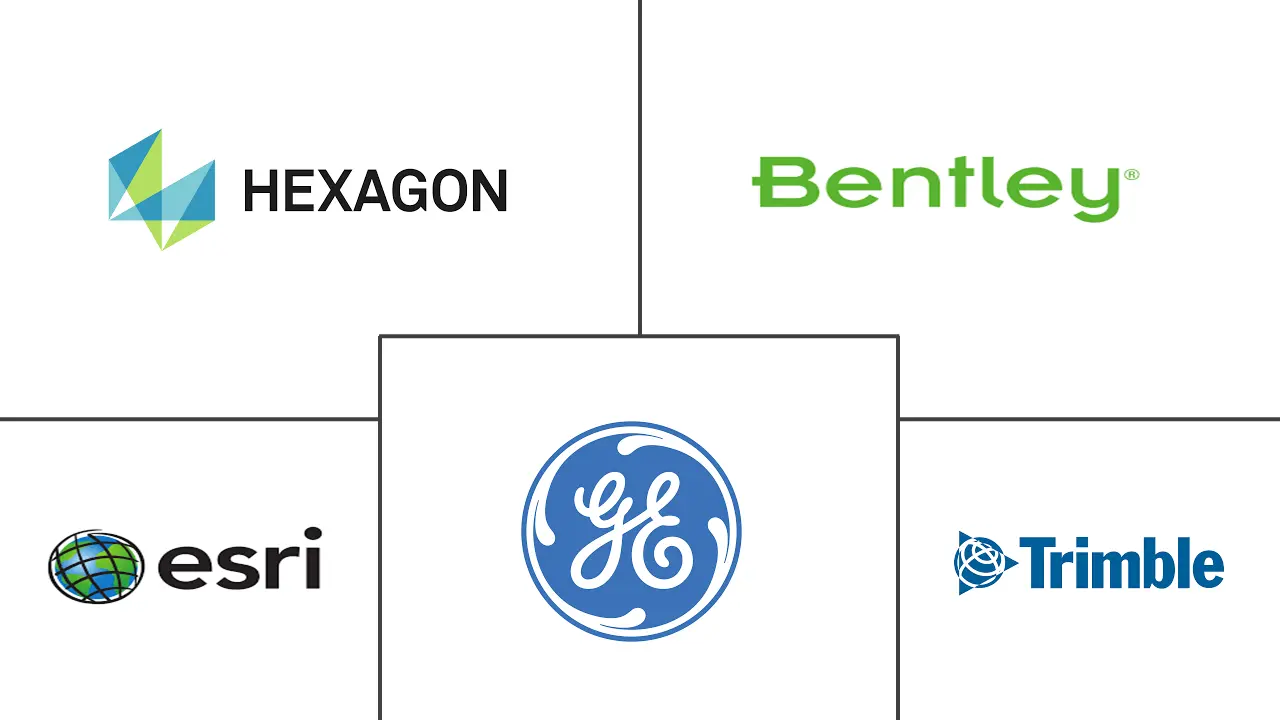Market Size of Germany Geospatial Analytics Industry

| Study Period | 2019 - 2029 |
| Base Year For Estimation | 2023 |
| Market Size (2024) | USD 1.30 Billion |
| Market Size (2029) | USD 2.28 Billion |
| CAGR (2024 - 2029) | 11.90 % |
| Market Concentration | Medium |
Major Players
*Disclaimer: Major Players sorted in no particular order |
Germany Geospatial Analytics Market Analysis
The Germany Geospatial Analytics Market size is estimated at USD 1.30 billion in 2024, and is expected to reach USD 2.28 billion by 2029, growing at a CAGR of 11.90% during the forecast period (2024-2029).
Deep learning, Artificial intelligence (AI), and machine learning (ML) are the following three technology trends that will significantly impact the geospatial business in Germany. Since Europe has one of the largest Earth Observation (EO) programs, organizations are quickly embracing these technologies for data processing and analytics. EO is altering how data will influence how individuals live their lives.
- The changing role of national geospatial institutions as they move from only supplying data to delivering knowledge is one of the leading market drivers of the German geospatial sector. For instance, federal geospatial agencies are promoting the creation of National Digital Twins in nations like the Netherlands, Germany, and Sweden in coordination with other governmental departments.
- Improved workflow integration across new vertical domains is another driver. The goal is to provide end-to-end services rather than using items or technology in isolation. This encourages even more cooperation and agreements between governments, non-geospatial industries, and the geospatial industry. For instance, many utility firms collaborate and partner to help build digital twins of the utility or subterranean infrastructure.
- Implementing new technology brings new challenges that may involve privacy-related concerns, as in the case of GIS and other mapping technologies. There have been several instances where gathering geospatial data earned the wrath of regional privacy and demographics laws.
- Ideally, new technologies need to be embraced and integrated into the social discourse to enable end users to gain benefits. However, certain governmental agencies have been very cautious about the 'democratization' of data, specifically in the case of sensitive installations. Societal responses to privacy issues that have come up because of the integration of GIS and GPS have primarily been mixed. However, there has also been an overriding sense of optimism over the benefits geospatial data offers.
Germany Geospatial Analytics Industry Segmentation
Geospatial analytics is acquiring, manipulating, and displaying imagery and data from the geographic information system (GIS), such as satellite photos and GPS data. The specific identifiers of a street address and a zip code are used in geospatial data analytics. They are used to create geographic models and data visualizations for more accurate trends modeling and forecasting.
The german geospatial analytics market is segmented by type (surface analysis, network analysis, geovisualization), by end user vertical (agriculture, utility and communication, defence and intelligence, government, mining and natural resources, automotive and transportation, healthcare, real estate, and construction). The market sizes and forecasts are provided in terms of value (USD) for all the above segments.
| By Type | |
| Surface Analysis | |
| Network Analysis | |
| Geovisualization |
| By End-user Vertical | |
| Agriculture | |
| Utility and Communication | |
| Defense and Intelligence | |
| Government | |
| Mining and Natural Resources | |
| Automotive and Transportation | |
| Healthcare | |
| Real Estate and Construction | |
| Other End-user Verticals |
Germany Geospatial Analytics Market Size Summary
The German geospatial analytics market is poised for significant growth, driven by advancements in deep learning, artificial intelligence, and machine learning. These technologies are transforming the geospatial landscape, particularly in the context of Europe's extensive Earth Observation programs. The market is further propelled by the evolving role of national geospatial institutions, which are shifting from mere data providers to knowledge deliverers. This transition is exemplified by initiatives like the National Digital Twins in collaboration with various governmental departments. The integration of geospatial analytics across diverse sectors is fostering enhanced collaboration between governments and non-geospatial industries, although challenges related to privacy and data democratization persist.
The advent of 5G technology is set to revolutionize the geospatial analytics market in Germany by offering unprecedented connectivity and data processing capabilities. This technological leap is crucial for network architecture and service delivery, especially in urban areas with dense infrastructure. Collaborations between key industry players, such as Mapbox and Ookla, are enhancing connectivity-aware mapping solutions, while partnerships in the automotive sector, like those between Mercedes-Benz and Google, are advancing digital navigation and automated driving technologies. The market is moderately consolidated, with major players like Hexagon, Trimble, and ESRI Inc. investing in strategic partnerships and product innovations to expand their market presence. Recent developments, such as UP42's collaboration with Vexcel and Bentley Systems' acquisition of Flow State Solutions, highlight the ongoing efforts to enhance geospatial data offerings and applications across various industries.
Germany Geospatial Analytics Market Size - Table of Contents
-
1. MARKET INSIGHTS
-
1.1 Market Overview
-
1.2 Industry Attractiveness - Porter's Five Forces Analysis
-
1.2.1 Bargaining Power of Buyers
-
1.2.2 Bargaining Power of Suppliers
-
1.2.3 Threat of New Entrants
-
1.2.4 Threat of Substitutes
-
1.2.5 Intensity of Competitive Rivalry
-
-
1.3 Industry Value Chain Analysis
-
1.4 Assessment of the Impact of COVID-19 on the Market
-
-
2. MARKET SEGMENTATION
-
2.1 By Type
-
2.1.1 Surface Analysis
-
2.1.2 Network Analysis
-
2.1.3 Geovisualization
-
-
2.2 By End-user Vertical
-
2.2.1 Agriculture
-
2.2.2 Utility and Communication
-
2.2.3 Defense and Intelligence
-
2.2.4 Government
-
2.2.5 Mining and Natural Resources
-
2.2.6 Automotive and Transportation
-
2.2.7 Healthcare
-
2.2.8 Real Estate and Construction
-
2.2.9 Other End-user Verticals
-
-
Germany Geospatial Analytics Market Size FAQs
How big is the Germany Geospatial Analytics Market?
The Germany Geospatial Analytics Market size is expected to reach USD 1.30 billion in 2024 and grow at a CAGR of 11.90% to reach USD 2.28 billion by 2029.
What is the current Germany Geospatial Analytics Market size?
In 2024, the Germany Geospatial Analytics Market size is expected to reach USD 1.30 billion.

